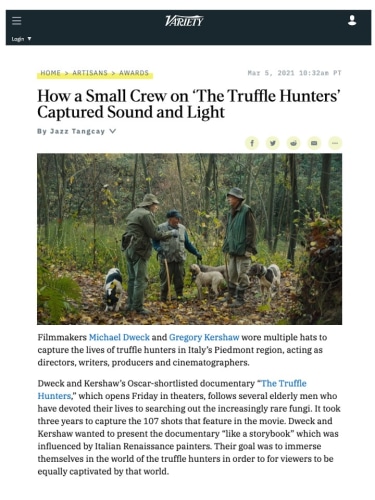How a Small Crew on ‘The Truffle Hunters’ Captured Sound and Light
Variety
03/05/2021
Back
By Jazz Tangcay
Filmmakers Michael Dweck and Gregory Kershaw wore multiple hats to capture the lives of truffle hunters in Italy’s Piedmont region, acting as directors, writers, producers and cinematographers.
Dweck and Kershaw’s Oscar-shortlisted documentary “The Truffle Hunters,” which opens Friday in theaters, follows several elderly men who have devoted their lives to searching out the increasingly rare fungi. It took three years to capture the 107 shots that feature in the movie. Dweck and Kershaw wanted to present the documentary “like a storybook” which was influenced by Italian Renaissance painters. Their goal was to immerse themselves in the world of the truffle hunters in order to for viewers to be equally captivated by that world.
The filmmakers break down how they used a very small crew and honed in on sound and lighting as their way in.
Inside the Lives of the Truffle Hunters
Michael Dweck: For us to immerse ourselves in this world took time, it took three years. We spent time with their families before we even shot anything. We realized that the film should be an immersion, and our challenge was how to take the audience into this place.
Because it was just the two of us, we were there all the time. On the first trip, we spent three weeks there. We spent time with seven truffle hunters and their families. Eventually, we were sharing meals with them, we were drinking espressos, we were on the farms and they’d have a routine, and we’d be there.
We’d set the camera up – in the scene where Carlo and Maria are having dinner, that camera would roll for three hours. There are 107 shots in the entire film, and each one of those shots is a little clip of that footage [which we edited down] to make the story flow.
We wanted to immerse the audience into the subjective experience of this place, and we had a creative sound person. We believed the soundscape of the film has equal weight to the narrative of the film.
We had our sound person, Mirko Guerra there and we’d leave him to capture all the nuances. When Angelo is cooking the chicken in the kitchen, the floor is marble, so that sounds different.
In Carlos’ home, he has wood floors, so we recorded the hinges and creaks. We recorded the wind going through the pine trees and oak trees because even then that’s a different sound from one another.
We had dogs barking and different types of church bells. You hear a stream that you can’t see.
If you listen carefully, you’ll hear this melody throughout and each character has a subtle sound. With Angelo, you’ll hear a faint church bell, Carlos’ dog has a different bell because she has a bell around her neck.
In another scene, we were trying to film Aurelio truffle hunting and he bursts into song. We realized singing was a part of his world, and we wanted to capture that. We have pop music from the ‘60s, and we have this Enrico Caruso recording from 1926 that we remastered and blended with an orchestra.
Lighting Influences
We spent a lot of time talking about Italian painters as influences and inspirations.
Gregory Kershaw: We never wanted to emulate a particular person. Our primary influence was looking at this world and how to capture the feeling of this place; that motivated all our decisions.
It was just Micahel and I in this van for the longest time. You couldn’t be in Italy shooting this world without talking about Caravaggio and how he used light to frame movement. His images are so incredibly complex and filled with drama, and the light is part of that drama.
In some images, we were thinking the same way where we wanted the light to tell the story we wanted to tell.
We would never light from the ground out. More often than not, instead of adding light, we were subtracting light. We traveled with two small sky panels and that was our entire lighting for the film.
We were staring at some of these valleys where Sergio was truffle hunting and listening to this symphony of sounds coming from nature. We decided to take this storybook look to bring this film to an audience,
Dweck: I think Raphael was also another influence with the way he used light to tell his stories.
Camera Gear:
Gregory Kershaw: We didn’t come to this project with a story. We just came to it with this fascination and this love for this place. And before we had any idea of what the story was going to be and how we were going to tell we just knew that we wanted to use cinema to capture a feeling.
We realized time was our friend. Somedays we would shot one day, other days we shot nothing. It was about waiting for the right shot.
Dweck: We used the Arri Alexa Mini and Angénieux lenses because it was the easiest for what we were going to do and because we were moving around.
We also knew were going to be on a tripod most of the time so the weight wasn’t necessarily an issue because once we built that camera out it was going to be quite heavy.
There was an additional layer to that shot because we rented the camera from an Italian rental house. They only had a tripod head from a 1960s Fellini movie. So the head weighed 30 kilos. We had a tripod that weighed 50 kilos, and we had a camera and lens that probably weighed another 50 kilos as we going down this muddy cliff [in that opening scene].